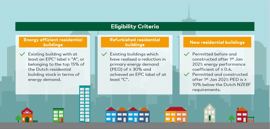Sustainable growth
Sustainable growth
A greener and sustainable future is a top priority for the European Union, now that the 2030 target date for achieving the environmental goals set out in the Paris Agreement and the UN’s Sustainable Development Goals is coming closer. The question is not so much whether a sustainable society and economy is necessary, but rather how quickly and effectively this transition can be achieved.
The EU sees the financial sector as a key player in mobilising the capital required to fulfil its sustainability agenda. At the same time, investors have an increasing need for a) insight in relevant financial risks stemming from climate change, resource depletion, environmental degradation and social issues and b) reliable information on a company's sustainability goals, to base their investment decisions on. In order to harmonise ESG disclosure standards, the EU is rolling out an extensive framework of legislation and regulations in the coming years as part of the EU Green Deal.
Instrumental in harmonizing disclosure on ESG is the use of uniform “green language” to distinguish which investments contribute to the European environmental objectives. For this purpose the EU Taxonomy is introduced. The EU Taxonomy is a list of economic activities within different sectors with technical screening criteria to substantially contribute and not to significantly harm environmental objectives.
Sustainable Finance Disclosure Regulation
What does this mean for Vesteda?
For Vesteda, the Sustainable Finance Disclosure Regulation (“SFDR”), which has come into effect on March 10, 2021, is a material part of EU legislation in this regard. The SFDR seeks to increase transparency on how financial market participants like asset managers integrate sustainability risks and opportunities into their investment decisions and recommendations. It will require them to classify all their investment funds into three categories of sustainability level – grey, light green and dark green – and to adjust their documentation, marketing material and reporting to reflect this. This standardised product labelling will give investors a better insight throughout the market on how sustainable investments actually are.
The SFDR imposes certain disclosure obligations on alternative investment fund managers, both regarding the manager itself (“entity level”) and the financial products they offer (‘product level”). Given the fact that the sole purpose of Vesteda’s manager, Vesteda Investment Management B.V. (the “entity”), is to manage Vesteda Residential Fund (the “product”), this distinction is somewhat artificial, but, where required, applied.
It is noted that the SFDR disclosure obligations are a work in progress, pending the development and roll-out of further legislation and guidelines, such as Regulatory Technical Standards to the SFDR and Technical Screening Criteria to the EU Taxonomy, in the coming years. We aim to provide full transparency regarding our implementation of the SFDR and will provide updates on this part of our website regularly when new RTS and further guidance is provided at EU level.
Taxonomy Alignment
Vesteda Residential Fund qualifies as an ‘article 8’ product under the SFDR and, as such, promotes Environmental/Social (E/S) characteristics. Whilst it does not have sustainable investment as its objective, it has a proportion of 45.2% in sustainable investments (of which 2.5% partially aligned) with an environmental objective in economic activities that qualify as environmentally sustainable (contributing to the environmental objective ‘mitigation of climate change’) under the EU Taxonomy at 30 June 2022.
The EU Taxonomy sets out a “do not significant harm” principle by which Taxonomy-aligned investments should not significantly harm EU Taxonomy objectives and is accompanied by specific EU criteria.
The “do no significant harm” principle applies only to those investments underlying the financial product that take into account the EU criteria for environmentally sustainable economic activities. The investments underlying the remaining portion of this financial product do not take into account the EU criteria for environmentally sustainable economic activities.


